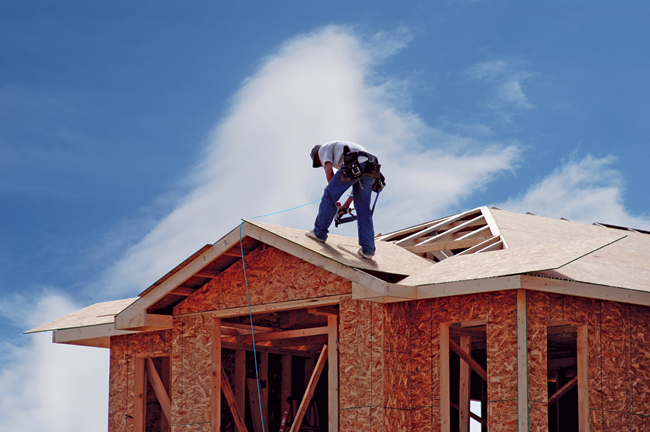Expansion and Contraction
The construction industry added 33,000 jobs in February even as the industry’s unemployment rate was 21.8 percent, more than twice the national average, according to an analysis of federal employment data released by the Associated General Contractors of America (AGC). As welcome as the new figures are, association officials cautioned that it was too early to tell whether the industry is improving or simply benefitting from the more favorable weather in February compared to the previous month.
“Given what this industry has been through, figures like these are as welcome as they are long overdue,” said Ken Simonson, the association’s chief economist. “The question now is whether these figures reflect a thaw in economic conditions for the industry or the benefits of warmer weather and less snow in many parts of the country in February.”

Simonson cautioned that despite experiencing the single largest monthly gain in construction employment since March 2007, construction employment is still down by over 2.2 million from the industry’s April, 2006 peak, a nearly 30 percent decline. At that time, over 7.7 million people worked in construction nationwide, while the industry now employs only 5.5 million people, Simonson noted. He added that for the 47th consecutive month, the February total was lower than the same month a year before.
The construction economist noted that both residential and nonresidential construction sectors added jobs in February. The largest gains came from the nonresidential specialty trade sector, which added 16,700 jobs during the month. Residential specialty trade contractors added another 11,000 jobs in February. The only segment of the construction industry to shed jobs in February was nonresidential building, which lost 2,000 jobs.
Association officials said that construction employment is likely to post modest gains at best through much of 2011 as stimulus funds dry up and private demand for construction recovers slowly. They added that continued uncertainty about the size and extent of federal budget cuts, combined with repeated delays in enacting multi-year infrastructure investment and repair programs, would make it hard for many construction firms to add jobs.
“As heartwarming as these gains are, it will be hard for the industry to build on this momentum in the face of weak demand and continued political gridlock,” said Stephen E. Sandherr, the association’s CEO. “The certainty that comes with having long-term federal investment programs in place for highway, transit, airport and water programs will give this industry the stability it needs to recover.”
Nonresidential Construction Spending Plummets 6.9 Percent
In a further sign that the nation’s builders continue to struggle after the recession, private nonresidential construction spending fell 6.9 percent in January, according to the March 1 report by the U.S. Commerce Department. Year-over-year, private nonresidential construction spending is down 13.2 percent. Total nonresidential construction spending — which includes both privately and publicly financed construction — was down 3.3 percent in January and 5.3 percent lower from the same time last year, and now stands at $536.7 billion.
Those subsectors posting the largest monthly percentage losses in spending include: lodging, down 20.2 percent; power, down 10.9 percent; health care, down 6.4 percent; amusement and recreation, down 6.2 percent; and office, down 5.2 percent. The subsectors with the largest losses year-over-year continue to be: lodging, down 44.9 percent; manufacturing, down 25.5 percent; and office construction, down 22.6 percent.
Five of the 16 nonresidential construction sectors still managed to post increases for the month including: conservation and development, up 5.5 percent; public safety, up 4.4 percent; water supply construction, up 2.3 percent; and transportation, up 1.2 percent. Six subsectors were higher from the same time last year including: water supply, up 18 percent; conservation and development, up 14.6 percent; highway and street, up 11.3 percent; transportation, up 8.2 percent; and power, up 5.2 percent.
Public nonresidential construction spending was flat for the month and up 2.5 percent from January 2010. Residential construction spending surged 5.1 percent for the month, but was still down 7 percent from the same time last year. Total construction spending — which includes both nonresidential and residential — was down 0.7 percent from December 2010 and 5.9 percent lower from one year ago.
“One could simply disregard January’s construction performance as a reflection of meteorological rather than economic phenomena,” said Associated Builders and Contractors chief economist Anirban Basu. “It was cold and snowy, and it is likely that weather played a role in suppressing overall activity. Further, the construction employment data from January, released [in February], also appears to support this notion.
“While the nation’s bad weather explains part of the situation, it’s clear that economics was also at play,”
said Basu. “Remarkably, total construction spending in America would have expanded in January relative to December had it not been for a sharp decline in energy-related construction. Spending on construction related to this sector fell from $94 billion on a seasonally adjusted annualized basis to $84 billion. That more than offset the gain of $4 billion in spending in the overall U.S. construction sector.
“However, the gain in non-energy-related construction spending was largely driven by residential construction, which experienced an increase in construction spending of more than $12 billion in January on a monthly basis,” Basu said. “Nonresidential construction spending remained negative on a monthly basis even when one excludes the performance of the energy subsector.

“In the final analysis, the January construction spending data supports the notion that the recovery in nonresidential construction has not yet begun,” said Basu. “It is possible that weather has merely delayed this process and that broader economic fundamentals will eventually shine through in the spring. Unfortunately, it is also possible that the economic fundamentals do not yet support recovery in the nation’s construction industry, and that the cold temperatures of January were merely incidental.”
New Home Sales Decline 12.6 Percent
Sales of newly built, single-family homes declined 12.6 percent to a seasonally adjusted, annual rate of 284,000 units in January, according to newly released figures from the U.S. Commerce Department. The decline largely offsets a big gain in sales activity that was recorded in the previous month due partly to an expiring tax break in California.
“While poor weather conditions likely played a part in keeping potential buyers on the sidelines this January, we do expect consumer demand to improve somewhat along with job-market gains heading into the spring buying season,” noted Bob Nielsen, chairman of the National Association of Home Builders (NAHB) and a home builder from Reno, Nev. “However, with the already-thin inventory of new homes for sale continuing to decline and the consistent unavailability of construction credit, the question is whether builders will be able to meet the improving demand as it emerges.”
“This latest report shows new-home sales activity returning to a rate that is consistent with the low level of activity seen in the third and fourth quarters of 2010,” said NAHB chief economist David Crowe. “Builders are clearly facing a competitive disadvantage with regard to the large inventory of existing homes at a time when they are unable to replenish their own inventories due to a lack of available financing.”
Regionally, new-home sales declined 12.8 percent in the South and 36.5 percent in the West, but gained 54.5 percent from a very low number in the Northeast and rose 17.1 percent in the Midwest this January. Meanwhile, the inventory of new homes for sale continued to edge downward, by 0.5 percent to 188,000 units in January. This amounts to a 7.9-month supply at the current sales pace.

Comments are closed here.